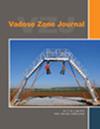除草剂在作物蒸渗仪中的命运:1。不同过程和模型结构对渗流带流动的影响
IF 2.8
3区 地球科学
Q3 ENVIRONMENTAL SCIENCES
引用次数: 1
摘要
了解地下的迁移和归宿过程对于确定除草剂或其他化合物对地下水资源的浸出潜力至关重要。HYDRUS‐1D用于模拟耕地蒸渗仪中的水流和溶质运移。模拟结果与观测到的排水速率和排水中的稳定水同位素(δ18O)进行了比较。研究了四种不同的模型设置,并对其模型性能进行了统计评估,以确定在相似的栽培管理和气候条件下渗流带水流特征的主导过程。所研究的蒸渗仪包含以砂砾(Ly1)和粘质砂质粉土(Ly2)为主的岩芯,这两种土都是在德国维伦巴赫种植的玉米。首先,选择单一孔隙度设置。对于Ly1,建模结果是令人满意的,但对于Ly2,在排水的同位素特征中观察到的阻尼不能完全覆盖。通过为Ly2考虑具有双重孔隙设置的固定水,模型性能得到了改善。这可能是由于Ly2中可用于蓄水的细孔比例较高,导致同位素富集的夏季降水和较轻的冬季水的混合过程。在两个模型设置中考虑同位素蒸发分馏过程并没有提高模型性能。因此,两个蒸渗计之间土壤水力特性的差异似乎会影响水流过程。了解这些差异对于防止污染和减轻土壤和地下水的潜在风险至关重要。本文章由计算机程序翻译,如有差异,请以英文原文为准。
Fate of herbicides in cropped lysimeters: 1. Influence of different processes and model structure on vadose zone flow
Understanding transport and fate processes in the subsurface is of fundamental importance to identify the leaching potentials of herbicides or other compounds to groundwater resources. HYDRUS‐1D was used to simulate water flow and solute transport in arable land lysimeters. Simulations were compared to observed drainage rates and stable water isotopes (δ18O) in the drainage. Four different model setups were investigated and statistically evaluated for their model performance to identify dominant processes for water flow characterization in the vadose zone under similar cultivation management and climatic conditions. The studied lysimeters contain soil cores dominated by sandy gravel (Ly1) and clayey sandy silt (Ly2), both cropped with maize located in Wielenbach, Germany. First, a single‐porosity setup was chosen. For Ly1, modeling results were satisfactory, but for Ly2, the damping observed in the isotope signature of the drainage could not be fully covered. By considering immobile water with a dual‐porosity setup for Ly2, model performance improved. This could be due to a higher fraction of fine pores in Ly2 available for water storage, leading to mixing processes of isotopically enriched summer precipitation and lighter winter water. Accounting for isotopic evaporation fractionation processes in both model setups did not lead to improved model performance. Consequentially, the difference in soil hydraulic properties between the two lysimeters seems to impact water flow processes. Knowledge of such differences is crucial to prevent contamination and mitigate potential risks to soil and groundwater.
求助全文
通过发布文献求助,成功后即可免费获取论文全文。
去求助
来源期刊

Vadose Zone Journal
环境科学-环境科学
CiteScore
5.60
自引率
7.10%
发文量
61
审稿时长
3.8 months
期刊介绍:
Vadose Zone Journal is a unique publication outlet for interdisciplinary research and assessment of the vadose zone, the portion of the Critical Zone that comprises the Earth’s critical living surface down to groundwater. It is a peer-reviewed, international journal publishing reviews, original research, and special sections across a wide range of disciplines. Vadose Zone Journal reports fundamental and applied research from disciplinary and multidisciplinary investigations, including assessment and policy analyses, of the mostly unsaturated zone between the soil surface and the groundwater table. The goal is to disseminate information to facilitate science-based decision-making and sustainable management of the vadose zone. Examples of topic areas suitable for VZJ are variably saturated fluid flow, heat and solute transport in granular and fractured media, flow processes in the capillary fringe at or near the water table, water table management, regional and global climate change impacts on the vadose zone, carbon sequestration, design and performance of waste disposal facilities, long-term stewardship of contaminated sites in the vadose zone, biogeochemical transformation processes, microbial processes in shallow and deep formations, bioremediation, and the fate and transport of radionuclides, inorganic and organic chemicals, colloids, viruses, and microorganisms. Articles in VZJ also address yet-to-be-resolved issues, such as how to quantify heterogeneity of subsurface processes and properties, and how to couple physical, chemical, and biological processes across a range of spatial scales from the molecular to the global.
 求助内容:
求助内容: 应助结果提醒方式:
应助结果提醒方式:


